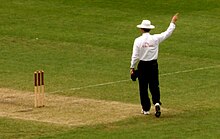Umpires and scorers
The game on the field is regulated by two umpires, one of whom stands behind the wicket at the bowler's end, the other in a position called "square leg", a position 15–20 metres to the side of the "on strike" batsman. When the bowler delivers the ball, the umpire at the wicket is between the bowler and the non-striker. The umpires confer if there is doubt about playing conditions and can postpone the match by taking the players off the field if necessary, for example rain or deterioration of the light.
Off the field and in televised matches, there is often a third umpire who can make decisions on certain incidents with the aid of video evidence. The third umpire is mandatory under the playing conditions for Test matches and limited overs internationals played between two ICC full members. These matches also have a match referee whose job is to ensure that play is within the Laws of cricket and the spirit of the game.
Off the field, the match details including runs and dismissals are recorded by two official scorers, one representing each team. The scorers are directed by the hand signals of an umpire. For example, the umpire raises a forefinger to signal that the batsman is out (has been dismissed); he raises both arms above his head if the batsman has hit the ball for six runs. The scorers are required by the Laws of cricket to record all runs scored, wickets taken and overs bowled. In practice, they accumulate much additional data such as bowling analyses and run rates.

No comments:
Post a Comment